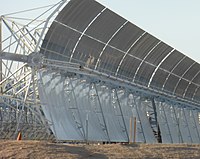
Photo from wikipedia
A new technique was proposed and implemented through an experimental model to improve the absorber tube of a parabolic trough collector, which was connected to a twisted tube and resulted… Click to show full abstract
A new technique was proposed and implemented through an experimental model to improve the absorber tube of a parabolic trough collector, which was connected to a twisted tube and resulted in a heat transfer enhancement. The enhancement increased the capacity of the tube to absorb solar energy by improving the convective transfer between the inner surface of the absorber tubes and the heat transfer fluid. The new design was dependent on overlapped and reverse flow, which was validated through five receiver tube $$(R_\mathrm{t})$$(Rt) models, each one consisting of two types of overlapped flows. The first was a flow through inner twisted tubes (single (STT), dual (DTT), and triple (TTT) twisted tubes), with different hydraulic diameters. The second was a reverse flow through an outer round tube, with both concentric tubes joined at one side by a bayonet end cap. For each $$R_\mathrm{t}$$Rt, the inlet flow from the central or peripheral tubes was assessed. The results showed a remarkable increase in heat transfer enhancement for most STT models and a greater heat transfer in TTT that was overlapped than for a plain tube collector. The enhancement was accompanied by an increase in the pressure difference that was higher for TTT than STT. For each model, the efficiency of the collector and pressure losses was estimated, and the Nusselt number (Nu) and an efficiency evaluation criterion were calculated.
Journal Title: Arabian Journal for Science and Engineering
Year Published: 2019
Link to full text (if available)
Share on Social Media: Sign Up to like & get
recommendations!